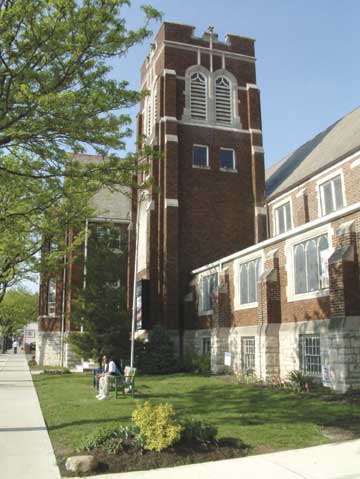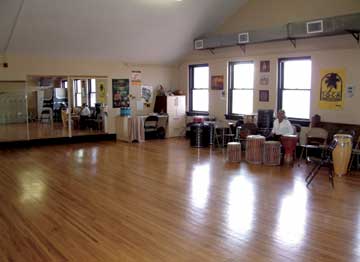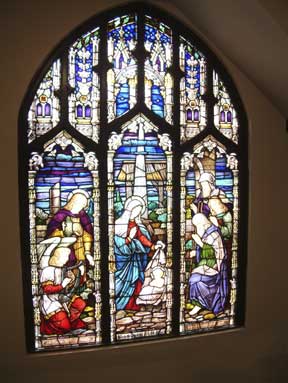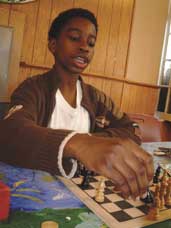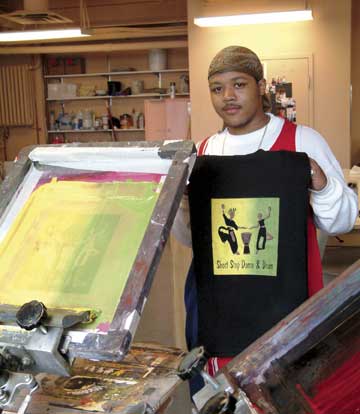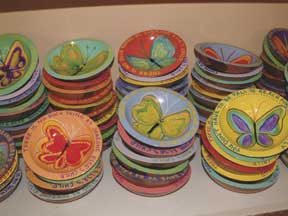
Columbus, Ohio USA
Return to Homepage www.shortnorth.com
Renovations Make Short Stop a Million Dollar Beauty
May 2005
By Karen Edwards
email kse@columbus.rr.com
© Photos by Gus Brunsman III
The building at 1066 N. High Street, housing the Short Stop Youth Center, was originally a Methodist Church constructed in the 1920s. The dust has cleared, the ladders are gone, the paintbrushes cleaned and put away. The renovation of the Short Stop Youth Center, 1066 N. High St. in the Short North, is now complete.
The million-dollar-plus overhaul has taken roughly six years.
But before anyone can truly appreciate the “after” effects of this renovation, it’s important to know the “before,” right?
So.
Picture this. A Methodist church, built sometime during the 1920s.
See the antiquated, fraying wires – updated once in the 1960s – that snake around the building, attempting to power up devices, like personal computers, that hadn’t even been invented when the wiring was new.
Feel the summertime heat and the blasts of winter cold, because parts of the building, including the sanctuary-turned-performance space, had no heating or air conditioning to improve comfort levels.
“The first thing we had to do was bring the building up to code,” says Iben “Chip” Smith, Short Stop’s program manager.
No kidding. In other words, this renovation was not going to be some sweet cosmetic job, a little touch of paint here and there. This was “Extreme Makeover.”
The chief concern was to make the building safe for the hundreds of kids who come through its doors each day to create.
Yes. Create.What goes on inside
It’s easy to glide by the old church each day – on your way home or to work – without even sparing a thought about what goes on inside. But you should know the Short Stop may be one of the most creative places in the Short North.
Technically, the Short Stop Youth Center is a program of Directions for Youth & Families, which encompasses 25 programs for youths and adults alike.
Over the years, Short Stop enfolded Crittenden Family Services into its program, and consequently has outgrown space after space, until it finally landed at its present address (along with a north side location on Indianola Avenue, and Sullivant Avenue on the west side.)
Before the renovation, the floor of this gymnasium-size dance studio
in the Center was covered with black latex paint.Physically and more importantly, spiritually, the Short Stop is a visual and performing arts center for youth. Think of it as a community Cultural Arts Center.
“Our focus,” says Smith, “is on getting young people involved in arts rather than on negative activity and behavior.”
In that task, the Short Stop has succeeded admirably.
Children, from elementary age up through high school, come to the Short Stop to paint and draw; to act and work behind-the-scenes; to dance; to sing; to design, to study, to relax, maybe shoot a little pool, and just hang out with friends.
The Short Stop Youth Center can accommodate them all.
As far as negative activity is concerned, Smith says it rarely surfaces.
“What impresses me the most, and what made the idea of a renovation even feasible, is that the kids treat this building with respect, like it’s their home,” Smith says.
He tells of working in a similar youth program, also in a renovated church, in the Youngstown area.
“All the stained glass in that church was protected by iron cages,” says Smith. “Here, we don’t have to do that.”
The stained glass windows at the Short Stop are beautiful – they’re jeweled Biblical stories come to life, and as open to view as they would be in any church. Yet not a single act of vandalism or even good-natured rowdiness has caused them harm.
The same is true of etched glass panes that make up the windows overlooking High Street in the first-floor recreation room. Sure, over time, some of the panes have been damaged, and, as Smith says, there is no replacing those, except with plain glass panes. But the number of etched glass panels remaining is staggering, considering the building is used almost exclusively by children.
It’s the stained glass and the etched window panes, the sanctuary’s vaulted ceiling and the staircase’s beautiful wood railing that prompted the second directive of the renovation.
“We needed to maintain the integrity of the building,” says Smith.
And finally, renovators wanted to make the Short Stop operate more efficiently.
Finding the $1 million
Of course, all renovations take money – hardly an easy topic for a program that operates on a shoestring, in a city where the arts take a back row seat to – well, just about everything.
Nevertheless, the Directions for Youth board of directors launched a Capital Campaign for renovation work. That was in 1999.
Money began to come in soon after from all over the city. The Columbus Rotary; corporations like Nationwide, Limited, Columbus Compact Corporation, Elford Construction; and Short North businesses like White Castle donated both funds and in-kind services. Private donors boosted the campaign as well.
“We had a good track record,” says Smith.
It made it easy for donors to contribute to the cause when they could see for themselves the works of art, the theater, the dances and singing that poured from youths, engaged in doing something they love.
“We’d ask potential donors, ‘What are your favorite memories of school?’” Smith said.
Invariably they’d remember a picture they painted for their mothers, the part they had in a school play. And they opened their wallets wider.
Actual renovation began in earnest in November 2003. Up until then, all improvements had been the structural kind – the work that brought the building up to code.
In November, structural renovations began to blend into cosmetic alterations. Now, things began to appear fresher, newer. Changes were more apparent.
“We had to do the renovations a bit at a time, as long as we could,” says Smith.
Marquis Taylor makes his move. After all, artists were still painting, dancers were still dancing, and both students and Bread and Circus Theatre, which performs regularly at the Short Stop Youth Center, were staging performances in the now heated and cooled performance space.
That meant a lot of cooperation between contractors and students and staff and visitors. According to Smith, everyone acted considerately. The students moved when they were asked to move, and operated out of increasingly limited space. They walked around tarps and two-by-fours. And the contractors kept the renovations confined to as small a space as they could at one time.
Finally, last September, the Short Stop Youth Center closed its doors for a two to three-week period. The remaining renovation work was done. And the doors opened again.The tour
Want to take a quick tour?
Walk up the staircase to the first landing. Don’t miss the gorgeous butterfly mural painted on the wall by one of the Short Stop’s resident artist-instructors. Its wings span practically the entire length.
The office is to your right, but let’s walk on through the door and into the performance space.
New carpeting lies underfoot.
“We didn’t carpet between the pews,” Smith says. Too hard to clean.
The stage now has electrical outlets in its base. Stage lights hang from tracks that circle the room. Sconces that fit the space’s “old world feel” serve as general lighting.
“Imagine this place with wires going everywhere,” says Smith. The space had few outlets, so electrical wires were connected to office outlets, and other plugs through long cables and extension cords. Not an ideal arrangement for either thespian or audience member.
Now, it’s a theater space that serves its purpose very well.
Short Stop students present three or four plays a year here – plays, like The Laramie Project and Black Girl – all designed to make the students and audience stop and think about the lessons of tolerance they teach.
Next door to the theater is a wide-open art space, well-lighted and with light wood floors.
Walk through the room, and a door leads you into a large recreation area with pool tables and those etched-glass windows.
Here, the ceiling was leveled and more light was added. The light wood floor stretches, this time, to a set of tables where students study or receive tutoring in just about every school subject.
Back through the art room, walk through yet another door, and you’re in a service kitchen.
“Before we renovated, you couldn’t use this kitchen at all,” Smith says. Its major occupant, a large, institutional, cast-iron stove, was removed and more appropriately sized appliances put in place.
“We hope to have cooking classes in here eventually,” says Smith.
Next door is the vocal room. Piano, new chairs, new carpet, paint. Currently, eight to ten children participate in the vocal program here. Smith hopes to build that up to a full-size chorus. The Short Stop Youth Singers are looking for a few good altos, sopranos, tenors, baritones and basses.
If you know of any, send them over.
Anthony Washington displays one of the T-shirts created at the Center with graphic design software and silk-screening equipment. Step through another door, and into the computer room, one of the few rooms to receive a make-over in 1999. Short Stop youth work here with graphic design software to create designs that are silk-screened onto tote bags and t-shirts in the art studio downstairs.
Then, it’s upstairs to the library, featuring floor-to-ceiling bookshelves. The Italian Village Society meets here on a monthly basis.
Across the hall is a gymnasium-size dance studio, with hardwood floors and floor-to-ceiling mirrors. Over in a corner stands an assortment of African drums.
“The floor in here was painted with black latex paint. It was a mess before we renovated,” says Smith.
Now the polished, bare floor is the perfect place for Short Stop dancers to beat their feet to the rhythms of the drums, performing not only traditional African dances, but samba, hip-hop, and liturgical dance as well. The dance ensemble is paid for performing – but the money is put right back into the group.
“Everything we make goes right back to the kids,” says Smith.
Outside the dance studio is a balcony that overlooks the performance space, where the stage manager sits during performances to call the show.
And now, we’re back downstairs, and down another set of stairs leading to the art studio.The art studio
On the way down, you’ll see photos of this year’s featured artists: boys and girls with enough talent and focus to be given a special room and special duties. The young artists who work here are paid on an hourly basis and are given a design fee for the custom work they render.
You’ll also pass by pictures of an “apprentice” artist, and a designated “clean-up” person – who may have the biggest responsibility of all.
Step inside the cavernous room and the first thing that strikes your eye are the colorful, hand-painted wooden bowls that completely cover one of the broad tables.
Smith picks one up. It’s covered with a butterfly and a delightful saying about children and smiles. “These are soul bowls,” he says.
“Soul bowls” and the similar “soul tiles” (two sizes of hand-painted ceramic tiles) are for sale at the Short Stop studio and at its Indianola-Avenue location as well as at the Short Stop Showcase, the program’s annual fund-raiser.
Other items made in the renovated art studio include custom-designed T-shirts (CAPA and the North Market have been customers), greeting cards, and business cards.
And these days, the studio is a much nicer place in which to work.
“We now have exhaust fans,” says Smith. And safety-glass windows. Unfortunately, the only place in the building to receive occasional damage from the street outside is the art studio. Its street-level windows on High Street have been targets for rock-throwing vandals in the past, but during the renovation, safety-glass windows were installed that let in light, but are impenetrable to such missiles.
New paint, new floor, new electrical wiring also helps modernize the studio.
Now, head back upstairs and out the door. The parking lot has been re-paved, and the sidewalk in front of the Center and around the side have all been renovated as well.
“It’s part of our commitment to the community,” says Smith.
There is no doubt that the renovated Short Stop is a star in the Short North landscape. But it’s not just the physical building or the recent renovation that makes it shine.
The young artists inside – many of whom will go on to college, including the Columbus College of Art and Design – are the Short Stop’s reason-for-being.
“I have the coolest job in the world,” says Smith. “Every day, I get to come to work, and see young people succeed.”
